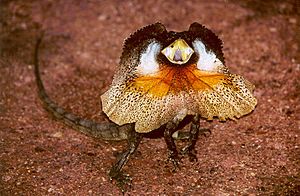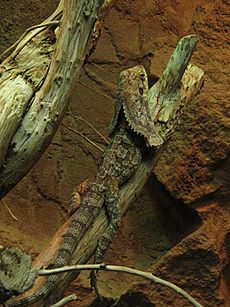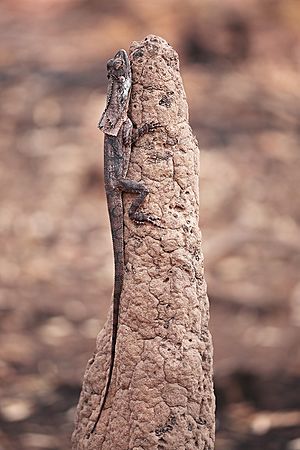Frill-necked Lizard facts for kids
Quick facts for kids Frill-necked lizard |
|
|---|---|
 |
|
| Scientific classification | |
| Kingdom: | |
| Phylum: | |
| Class: | |
| Order: | |
| Suborder: | |
| Infraorder: | |
| Family: | |
| Subfamily: |
Agaminae
|
| Genus: |
Chlamydosaurus
|
| Binomial name | |
| Chlamydosaurus kingii Gray, 1827
|
|
The frilled-necked lizard (Chlamydosaurus kingii), also known as the frilled lizard, frilled dragon or frilled agama, is a species of lizard which is found mainly in northern Australia and southern New Guinea. This species is the only member of the genus Chlamydosaurus.
Its common name comes from the large frill around its neck, which usually stays folded against the lizard's body. C. kingii is largely arboreal, spending the majority of the time in the trees. The lizard's diet consists mainly of insects and small vertebrates. The frill-necked lizard is a relatively large lizard, averaging 85 cm (2.79 ft) in total length (including tail) and is kept as an exotic pet.
Because of its unusual appearance, it is a popular subject in animation.
Description
The frill-necked lizard is a relatively large member of the agamid family, growing up to 85 cm (2.79 ft). It is capable of bipedal locomotion and has been described as regularly moving in this manner with a purposeful stride at times by naturalists.
Coloration tends to be brown or gray with spots and blotches of darker colors mixed in a mottled fashion to give the appearance of tree bark. There is not one standard colour: rather, colouration varies according to the lizard's environment. For example, a lizard found in a dryer, clay filled environment will most likely have a collage of oranges, reds, and browns; whereas a lizard found in a damper, more tropical region will tend to show darker browns and greys. This suggests they are adapted to their habitats; their colors are a form of camouflage.
The most distinct feature of these lizards is the large ruff of skin which usually lies folded back against its head and neck. The neck frill is supported by long spines of cartilage which are connected to the jaw bones. When the lizard is frightened, it produces a startling deimatic display: it gapes its mouth, exposing a bright pink or yellow lining; it spreads out its frill, displaying bright orange and red scales; raises its body; and sometimes holds its tail above its body. This reaction is used for territorial displays, to discourage predators, and during courtship.
The bones of the frill are modified elongate hyoid types that form rods which expand the frill. Secondarily the frill can serve as a form of camouflage when relaxed; there is no standard coloration to the body, but it is usually darker than the frill.
Distribution and habitat
The frilled-neck lizard is found mainly in the northern regions of Australia and southern New Guinea. The lizard on rare occasions is found in the lower desert regions of Australia but primarily inhabits humid climates such as those in the tropical savannah woodlands.
It tends to be an arboreal lizard, meaning it spends a majority of its time in the trees. The lizard ventures to the floor only in search of food, or to engage in territorial conflicts. The arboreal habitat may be a product of the lizard's diet, which consists mainly of small arthropods and vertebrates (usually smaller lizards). However, the trees are most importantly used for camouflage.
Diet
Like many lizards, frill-necked lizards are carnivores, feeding on cicadas, beetles, termites, and mice. They especially favor butterflies, moths and their larvae. Though insects are their primary source of food, they also consume spiders and occasionally other lizards. Like most members of the agamids (dragons), frill-necked lizards employ an ambush method of hunting, lying in wait for their prey. When the lizards eat, they eat in abundance; these binge periods usually occur during the wet season, when they ingest hundreds to thousands of alate (flying) ants or termites.
Thermoregulation
The frilled-neck lizard is ectothermic and maintains its body temperature by basking briefly to achieve an average of 2–3 °C above the surrounding temperature. Weather conditions, including sunlight, are the main factors regulating the lizards’ temperature. This basking period usually occurs in the morning to early afternoon to ensure maximum exposure to sunlight. However, the lizard's final internal temperature depends mainly on the ambient temperature of the surrounding environment. The lizard's frill was once thought to aid in thermoregulation, but this has been found without merit.
Predators
The species' main predators are eagles, owls, larger lizards, snakes, dingos and quolls.
In culture
A frill-necked lizard was featured on the reverse of the Australian 2-cent coin until 1991. A frill-necked lizard, known as "Lizzie," was the mascot for the 2000 Paralympic Games. The emblem of the Australian Army's Regional Force Surveillance Unit, NORFORCE (North-West Mobile Force) of the Kimberleys and Northern Territory is the frill-necked lizard.
Because of its unique appearance and behavior, the frill-necked lizard is commonly used in film and television. A frill-necked lizard named Frank appears in the Disney film The Rescuers Down Under. In the film Jurassic Park, the dinosaur Dilophosaurus was portrayed with a neck frill, which was raised during attack, similar to that of a frilled-neck lizard. The movie generated an increase in demand for frill-necked lizards as pets. In the CGI animated film Blinky Bill the Movie and so the animated television shows of The Wild Adventures of Blinky Bill Jacko a frill-necked lizard wears a black t-shirt voiced by David Wenham and Akmal Saleh.
See also
 In Spanish: Clamidosaurio de King para niños
In Spanish: Clamidosaurio de King para niños




